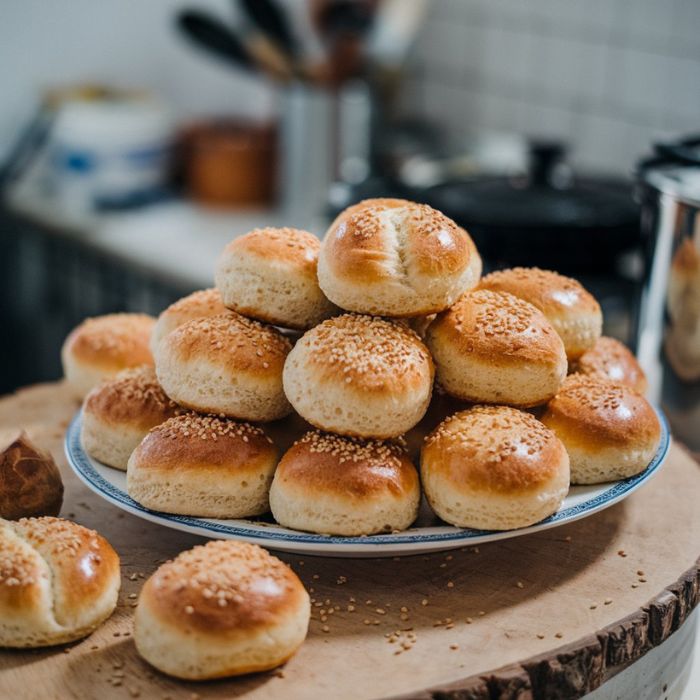Imagine pulling apart a warm, fluffy flatbread that perfectly complements your meal. That’s Kuboos for you—a beloved staple in many Middle Eastern households. This delectable bread has taken its place at the dining table, gracing everything from hearty stews to fresh salads. Whether you’re dipping it into creamy hummus or wrapping it around savory grilled meats, Kuboos is more than just a side dish; it’s an experience.
But what exactly makes this flatbread so special? Let’s dive into the fascinating world of Kuboos and discover its history, preparation methods, variations, and why it deserves a spot on your plate—and in your heart—no matter the occasion.
What is Kuboos?
Kuboos is a traditional Arabic flatbread that has captured the hearts and taste buds of many. Its soft, fluffy texture makes it remarkably versatile, allowing it to be enjoyed with various dishes.
Typically made from simple ingredients like flour, water, yeast, and salt, Kuboos is often baked in a hot oven or on a griddle until golden brown. This method creates that delightful puffiness we all love.
The bread is usually round and can range in size from small individual portions to larger versions meant for sharing. Whether it’s served warm or at room temperature, Kuboos always enhances the dining experience with its inviting aroma and taste.
Beyond just being a side dish, it’s also an essential component of Middle Eastern cuisine—perfect for scooping up dips or wrapping around savory fillings. Its charm lies not only in its flavor but also in how it brings people together over shared meals.
History and Origin of Kuboos
The origins of Kuboos trace back to the Middle East. This flatbread has been a staple for centuries, with roots in various cultures across the region.
Traditional methods of making Kuboos have evolved over time. Historical records suggest that it was first prepared by nomadic tribes as they traveled through arid landscapes. They needed a simple yet sustaining food source.
In many households, Kuboos became more than just nourishment; it took on cultural significance. Celebrations and family gatherings often featured this beloved bread.
As trade routes expanded, so did the popularity of Kuboos. Its adaptability made it a favorite among different communities, leading to variations that reflected local tastes and ingredients throughout history.
Traditional Ingredients and Preparation Method
Kuboos, a delightful flatbread, relies on simple yet essential ingredients. The core components are flour, water, yeast, and salt.
Traditionally, white flour is used to create its light texture. Whole wheat variations are also popular for added flavor and nutrition. Yeast helps the dough rise perfectly.
Preparation starts with mixing the dry ingredients before adding warm water. Kneading follows to develop gluten, which gives Kuboos its characteristic chewiness.
Once kneaded well, the dough rests until it doubles in size. This step is crucial for achieving that fluffy interior.
After resting, small balls of dough are flattened into discs and cooked at high heat in an oven or tandoor. The result? A soft bread with a slightly crispy exterior that’s perfect for scooping up dips or pairing with savory dishes!
Variations and Modern Twists on Kuboos
Kuboos isn’t just a traditional flatbread; it has evolved into a canvas for creativity. Chefs and home cooks alike are experimenting with flavors and textures, resulting in delightful twists on this classic.
One popular variation incorporates herbs like za’atar or coriander into the dough. This not only adds depth but also enhances its aroma. You might find kuboos infused with garlic or even spiced with chili flakes for an extra kick.
Moreover, some contemporary recipes experiment with whole wheat or gluten-free alternatives. These options cater to different dietary preferences while maintaining that beloved soft texture.
Stuffed kuboos have gained popularity too. Imagine biting into one filled with savory meats, cheeses, or roasted vegetables—delicious! Toppings can range from avocado spread to hummus, making each bite unique and satisfying.
The possibilities are endless when it comes to modern interpretations of kuboos. Each twist invites you to explore new flavors while respecting its rich heritage.
Kuboos Around the World
Different Names and Usage in Different Cultures
Kuboos, often known by various names across cultures, showcases its versatility globally. In Middle Eastern countries like Lebanon and Syria, it’s a staple enjoyed with hummus or grilled meats.
Traveling to India, you’ll find a similar flatbread called “roti” or “chapati,” which serves as an accompaniment to rich curries. Each region adapts the recipe slightly based on local tastes and ingredients.
In Ethiopia, injera takes center stage at communal meals but shares the same flatbread essence. It’s made from teff flour and has a distinct sour flavor.
The name may change, yet the enjoyment remains constant—whether wrapped around delicious fillings or used to scoop up savory dishes. This adaptability makes kuboos more than just food; it’s part of cultural expressions worldwide.
Kuboos as a Versatile Dish
Perfect for Every Occasion
Kuboos is more than just flatbread; it’s a culinary canvas. Its soft, fluffy texture makes it an ideal accompaniment for various dishes. Whether you are enjoying a savory curry or dipping into creamy hummus, Kuboos elevates the experience.
At gatherings, Kuboos shines as a versatile snack. Serve it warm with dips and spreads to create an inviting atmosphere. Guests can roll their favorite fillings inside or tear pieces off for sharing, making it perfect for social dining.
For breakfast, imagine pairing Kuboos with eggs and fresh vegetables or slathering on some jam. It adapts beautifully to any meal of the day.
Even in fusion cuisine, chefs experiment by adding unique spices or toppings. This adaptability keeps Kuboos relevant across cultures and occasions alike. Embrace its versatility and let your creativity flow in the kitchen!
Conclusion:
Why You Should Give Kuboos a Try
Kuboos is more than just flatbread; it’s a culinary experience that transcends borders and cultures. Its unique texture and flavor make it an ideal companion for various dishes, from savory curries to sweet dips. The simplicity of its ingredients offers a clean canvas for creativity in the kitchen.
Whether you’re enjoying traditional recipes or experimenting with modern twists, it can fit seamlessly into your meals. It adapts well to different diets too—vegan, gluten-free options are readily available. This versatility means there’s always a way to incorporate Kuboos into your dining repertoire.
Exploring these opens up new avenues for impressive appetizers, hearty wraps, and even delightful desserts. Its rich history adds depth to every bite, making each meal not just nourishing but also meaningful.
If you haven’t tried this delightful flatbread yet, now is the perfect time! Embrace the flavors and textures of Kuboos; it might just become a staple on your table as it has for many around the world. Enjoy discovering how this humble bread can elevate any occasion with ease and elegance.








